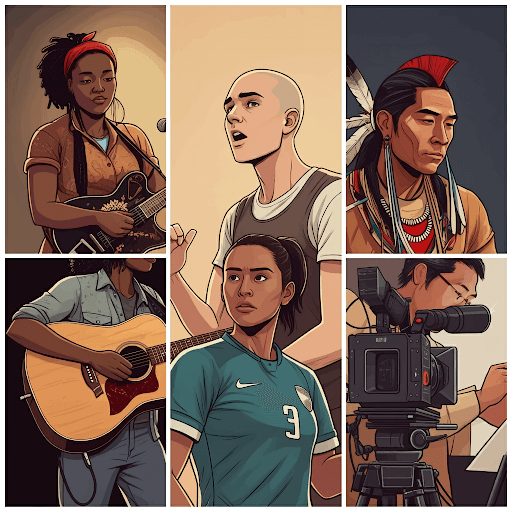Beyond the Bleachers: The Untapped Gen Z Sports Stories You’re Missing

Date: May 14, 2025
While major league broadcasts and superstar contracts dominate the headlines, a quieter but equally profound revolution is underway in the world of sports, driven by Generation Z. This cohort, born roughly between 1997 and 2012, isn’t just passively consuming the games of their parents; they are actively reshaping what it means to be an athlete, a fan, and a sports community member. Their preferences and habits are giving rise to new trends, platforms, and even entirely new sporting landscapes that many traditional outlets are only beginning to acknowledge. This article delves into the undercurrents of Gen Z sports engagement – the niche passions, digital-first habits, and value-driven consumption patterns that are not just changing the game but building entirely new ones.
The New Playing Field: Niche Sports Explode and Go Pro(ish)
One of the most striking shifts is Gen Z’s enthusiastic embrace of niche and alternative sports. While traditional sports like football and basketball still command significant attention, there’s a burgeoning interest in activities that offer greater self-expression, unique communities, and often, lower barriers to entry. Sports like skateboarding, surfing, and sport climbing, now Olympic fixtures, paved the way, but the current wave includes an even more diverse array of activities.
Pickleball, for instance, has seen an astronomical rise in popularity, becoming America’s fastest-growing sport for multiple years. Its appeal lies in its accessibility, social nature, and relatively easy learning curve, making it a hit across age groups but particularly resonant with Gen Z’s desire for inclusive and community-oriented activities. Similarly, 3×3 basketball, a faster-paced, more dynamic version of its 5-on-5 counterpart, has moved from street courts to official Olympic recognition, capturing the generation’s preference for quicker, more intense formats.
Beyond these, a fascinating ecosystem of hyper-niche sports is gaining traction, often fueled by online communities and viral content. Think of the strategic intensity of Drone Racing Leagues, the soccer-meets-ping-pong ingenuity of Teqball, or the athletic prowess displayed in World Chase Tag. These aren’t just quirky pastimes; they are evolving into organized competitions with dedicated fan bases and emerging professional circuits, demonstrating Gen Z’s willingness to explore and elevate sports beyond the conventional. The Kings League, founded by former footballer Gerard Piqué and streamer Ibai Llanos, exemplifies this trend with its 7-a-side football format featuring fan-voted rules and wildcard elements, perfectly tailored for digital consumption and engagement.
Athletes as Creators: The Direct-to-Fan Revolution
Perhaps more than any generation before them, Gen Z athletes understand the power of personal branding and direct engagement. They are not content to let traditional media outlets dictate their narratives. Instead, they are becoming media powerhouses in their own right, leveraging platforms like TikTok, YouTube, Instagram, and Twitch to connect with fans on an unprecedented level.
These digital-native athletes share behind-the-scenes glimpses of their training, their personalities, and their lives outside of competition, fostering a sense of authenticity and relatability that resonates deeply with their peers. This isn’t just about occasional posts; many are creating sophisticated content, from highlight reels and tutorials to vlogs and live Q&A sessions. This direct line to fans bypasses traditional gatekeepers, allowing athletes to control their image, build loyal followings, and even attract sponsorship deals independently.
The rise of “influencer sport” is another facet of this trend, where athletes and popular online personalities collaborate to create their own sporting events or content series. These often blend entertainment with competition, further blurring the lines and attracting audiences who might not engage with traditional sports broadcasts. This shift is forcing established sports organizations and media companies to rethink how they interact with both athletes and fans, recognizing that the power dynamic has fundamentally changed.
Snackable Sports & Second Screens: The New Consumption Model
Gen Z’s sports consumption habits are markedly different from those of previous generations. The days of sitting through an entire three-hour broadcast on a single screen are waning. This generation prefers “snackable” content: highlights, viral clips, and short-form videos that can be consumed quickly and easily, often on mobile devices. Platforms like TikTok and YouTube are central to this, serving as primary sources for sports updates and entertainment.
This preference for brevity and dynamism is leading to innovations in how sports are presented. “Altcasts” – alternative broadcasts often featuring more casual commentary, celebrity guests, or specialized data feeds (like ESPN’s “ManningCast” or Amazon Prime Video’s Next Gen Stats feed) – cater to a desire for more engaging and less formal viewing experiences. Leagues are also experimenting with formats designed for modern attention spans. Tomorrow’s Golf League (TGL), backed by Tiger Woods and Rory McIlroy, offers a high-tech, condensed, primetime version of golf, while The Hundred in cricket presents a faster, more action-packed game.
Multi-screen viewing is the norm, with Gen Z fans often engaging with social media, playing games, or chatting with friends while watching a sporting event. This creates opportunities for real-time interactive experiences, from live polls and Q&As to integrated betting (where appropriate) and branded QR codes, making sports viewing a more participatory and layered activity.
More Than a Game: Sports as a Social and Values-Driven Experience
For Gen Z, the social aspect of sports is paramount. Whether it’s joining local run clubs that offer a healthy alternative to traditional social outings, participating in vibrant online fan communities, or sharing moments from live events on social media, the communal experience is a key driver of their engagement. This extends to how they attend live events, where the experience is often as much about the social gathering and shareable moments as it is about the game itself.
Furthermore, this generation is increasingly values-driven, and this extends to their sports fandom. There’s a growing expectation that sports organizations, leagues, and athletes align with their social and environmental values. Sustainability in sports events, for example, is becoming a more significant consideration. The remarkable growth in viewership and interest in women’s sports is also heavily propelled by Gen Z, who champion gender equality and seek out diverse role models. They are more likely to support athletes and teams that speak out on social issues and demonstrate a commitment to positive change.
The Blurred Lines: Where Physical Meets Digital
While esports has carved out its own massive domain, the influence of gaming culture and digital interaction is increasingly permeating traditional sports consumption for Gen Z. This goes beyond simply playing sports video games. There’s an appreciation for gamified experiences, data-rich presentations, and interactive elements that mirror the engagement found in the gaming world.
Fantasy sports leagues continue to be popular, offering a deeper level of engagement and a personalized connection to player performance. The rise of legalized sports betting in many regions also adds another layer of interaction for those of age, transforming passive viewing into a more invested experience. Emerging technologies like augmented reality (AR) and virtual reality (VR) are beginning to offer new ways to experience sports, whether through enhanced broadcasts with AR overlays or immersive VR viewing experiences. Sports like HADO, an AR-powered version of dodgeball, represent a frontier where physical sport and digital technology fully merge, creating entirely new forms of athletic competition that are inherently attractive to a tech-savvy generation.
Conclusion: The Unfolding Future of Sport
Gen Z is not just the future audience for sports; they are its active co-creators. Their preference for diverse and niche activities, their mastery of digital platforms to create and consume content, their demand for shorter and more engaging formats, and their insistence on social connection and value alignment are collectively forcing a significant evolution in the global sports landscape.
The stories that often go untold by mainstream media – the rapid growth of community-based pickleball leagues, the athlete-creator building a global fanbase from their phone, the innovative league formats designed for a digital-first world, and the fan communities coalescing around shared values – are crucial indicators of where sport is headed. For leagues, broadcasters, sponsors, and anyone invested in the world of athletics, understanding and embracing these undercurrents is no longer optional; it’s essential for staying relevant in a future being dynamically shaped by its youngest and most transformative generation of fans and participants. The game is changing, and Gen Z is holding the whistle.
tik4tat research team Your Life-Your Future





